The Edogawa Rampo Memorial Center for Popular Culture Studies(The Edogawa Rampo Former Residence, Museum and Archives)
RESEARCH INSTITUTIONS
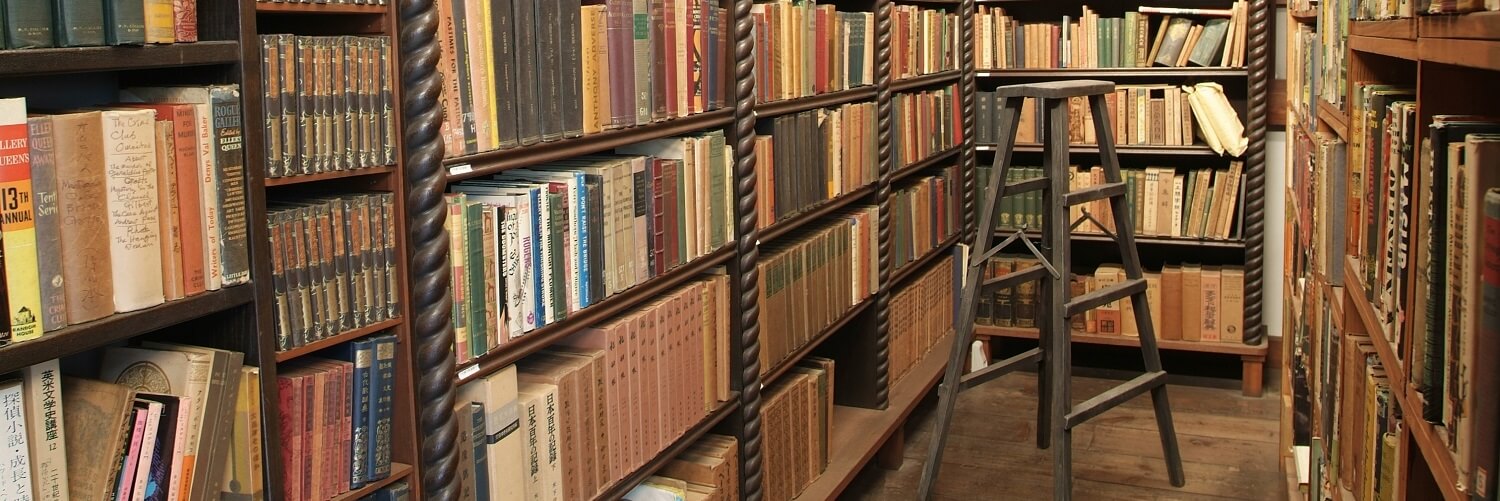
The Edogawa Rampo Memorial Center for Popular Culture Studies (The Edogawa Rampo Former Residence, Museum and Archives) was established as a research institution in 2006 to become a hub of popular culture studies from home and abroad, with a focus on old book collections and materials about Edogawa Rampo.
The main role of the Edogawa Rampo Residence is to curate, reserve, and exhibit buildings and materials about Rampo, produce a variety of scholarly works (such as “Taishu-bunka大衆文化” and “Senta-tsushinセンター通信”), and make the fruits of popular culture studies work available to the public through exhibitions and symposiums. The Edogawa Rampo Residence is open to the public every Wednesday, Friday and Special Exhibition Day. The book storehouse was designated as a cultural asset of Toshima-ku in 2003.
The main role of the Edogawa Rampo Residence is to curate, reserve, and exhibit buildings and materials about Rampo, produce a variety of scholarly works (such as “Taishu-bunka大衆文化” and “Senta-tsushinセンター通信”), and make the fruits of popular culture studies work available to the public through exhibitions and symposiums. The Edogawa Rampo Residence is open to the public every Wednesday, Friday and Special Exhibition Day. The book storehouse was designated as a cultural asset of Toshima-ku in 2003.
General Information
Opening Hours
Group reservations here
- Opening days: Every Monday, Wednesday, Friday (Except national / public holidays)
- Opening hours: 10:30 a.m.-4:00 p.m.
- Free, no reservation required
*If you are visiting with a group of 10 or more people, please make a reservation using the group reservation application form at least one week prior to your visit.
Group reservations here
- Opening hours are subject to change, so please check the calendar for the latest information.
About The Edogawa Rampo and The Edogawa Rampo Residence
About Edogawa Rampo (1894-1965)
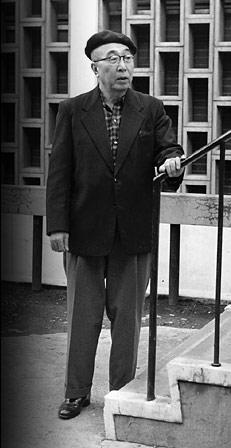
Edogawa Rampo’s real name is HIRAI Taro. He was born on October 21th, 1894 in Nagoya.
While studying economics at Waseda University, he read books by Edgar Allan Poe and Sir Arthur Ignatius Conan Doyle. After a variety of work experiences, he then made a debut as a writer in 1923. His debut volume was “Nishen Doka (二銭銅貨)”in a magazine “Shin seinen (新青年)”. By 1927, he had written “Dzakanosatsuzin (D坂の殺人)”, “Ningen-isu (人間椅子)”, “Panoramatoukitan (パノラマ島奇譚)”. After taking a break, he also released “Inju (陰獣)”, “Imomushi (芋虫)”, “Koto-no-Oni (孤島の鬼)”, and “Oshietotabisuruotoko (押絵と旅する男)”.
From 1929, he started to serialize a long novel in a magazine for amusement, “Kumo-otoko (蜘蛛男)”, “Majutsushi(魔術師)”, “Ogonkamen(黄金仮面)”, “Kurotokage(黒蜥蜴)”, and so on.
From 1936, he started to serialize “Kaijin-Nijumensou (怪人二十面相)” in a magazine “Shonenkurabu (少年倶楽部)”, which he continued until late in his career. At the same time, he wrote many critical essays, which were collected in “Oninokotoba (鬼の言葉)” (1936) and “Geneijo (幻影城)” (1951).
In 1947, the Detective Writers Club was formed, and Rampo became the first chairperson. In 1954, he established the Rampo Prize.
In 1957, he took part in editing a magazine “Houseki (宝石)”.
In 1963, the Mystery Writers of Japan Association was established, and he assumed the role of Director.
On July 28th, in 1965, Rampo passed away of brain hemorrhage. His age at death was 70.
While studying economics at Waseda University, he read books by Edgar Allan Poe and Sir Arthur Ignatius Conan Doyle. After a variety of work experiences, he then made a debut as a writer in 1923. His debut volume was “Nishen Doka (二銭銅貨)”in a magazine “Shin seinen (新青年)”. By 1927, he had written “Dzakanosatsuzin (D坂の殺人)”, “Ningen-isu (人間椅子)”, “Panoramatoukitan (パノラマ島奇譚)”. After taking a break, he also released “Inju (陰獣)”, “Imomushi (芋虫)”, “Koto-no-Oni (孤島の鬼)”, and “Oshietotabisuruotoko (押絵と旅する男)”.
From 1929, he started to serialize a long novel in a magazine for amusement, “Kumo-otoko (蜘蛛男)”, “Majutsushi(魔術師)”, “Ogonkamen(黄金仮面)”, “Kurotokage(黒蜥蜴)”, and so on.
From 1936, he started to serialize “Kaijin-Nijumensou (怪人二十面相)” in a magazine “Shonenkurabu (少年倶楽部)”, which he continued until late in his career. At the same time, he wrote many critical essays, which were collected in “Oninokotoba (鬼の言葉)” (1936) and “Geneijo (幻影城)” (1951).
In 1947, the Detective Writers Club was formed, and Rampo became the first chairperson. In 1954, he established the Rampo Prize.
In 1957, he took part in editing a magazine “Houseki (宝石)”.
In 1963, the Mystery Writers of Japan Association was established, and he assumed the role of Director.
On July 28th, in 1965, Rampo passed away of brain hemorrhage. His age at death was 70.
Rampo and Literatures in Rikkyo University

According to 「東京市に於ける住居転々の図」(貼雑年譜), Rampo had moved 26 times within Tokyo. The final residence was a leasehold house with a storehouse, whose rent was 90 yen in Ikebukuro, 3-1626, Toshima-ku. It was promoted from “gun(a district郡)”to “ku(a ward区)”in 1932.
In 1934 July, Rampo decided to live in Ikebukuro. Rikkyo University and the Anglican Church were both located near here, and that was the beginning of the special fate that tied together Rampo and Rikkyo University. Though Rampo had thought about moving again, he spent half of his life here until 1965. 40 years after his death, the Edogawa Rampo Residence was reverted to Rikkyo University in 2002.
There could be any number of reasons why Rampo selected Ikebukuro, and why he never moved from there. One possible reason is that the Edogawa Rampo Residence was surrounded by plum-groves, azaleas, soil, grasses, and an artificial hill. Also, it was a calm place in those days compared with his previous noisy residence in Kuruma-cho, Shiba-ku. It seems that Rampo washed his hands of such a squalid atmosphere and was drawn to the beautiful nature of the Ikebukuro area.
Another issue is that Rampo developed relationships with his neighbors in the wartime. After the war, the busy streets of Ikebukuro under reconstruction would have become his home turf. At the same time, there was also a strong private bond with Rikkyo through his family. Looking back at this context, it is natural that the Edogawa Rampo Residence came to be reborn as a symbol of Rikkyo University and the surrounding area.
In 1934 July, Rampo decided to live in Ikebukuro. Rikkyo University and the Anglican Church were both located near here, and that was the beginning of the special fate that tied together Rampo and Rikkyo University. Though Rampo had thought about moving again, he spent half of his life here until 1965. 40 years after his death, the Edogawa Rampo Residence was reverted to Rikkyo University in 2002.
There could be any number of reasons why Rampo selected Ikebukuro, and why he never moved from there. One possible reason is that the Edogawa Rampo Residence was surrounded by plum-groves, azaleas, soil, grasses, and an artificial hill. Also, it was a calm place in those days compared with his previous noisy residence in Kuruma-cho, Shiba-ku. It seems that Rampo washed his hands of such a squalid atmosphere and was drawn to the beautiful nature of the Ikebukuro area.
Another issue is that Rampo developed relationships with his neighbors in the wartime. After the war, the busy streets of Ikebukuro under reconstruction would have become his home turf. At the same time, there was also a strong private bond with Rikkyo through his family. Looking back at this context, it is natural that the Edogawa Rampo Residence came to be reborn as a symbol of Rikkyo University and the surrounding area.
Rampo’s Literature
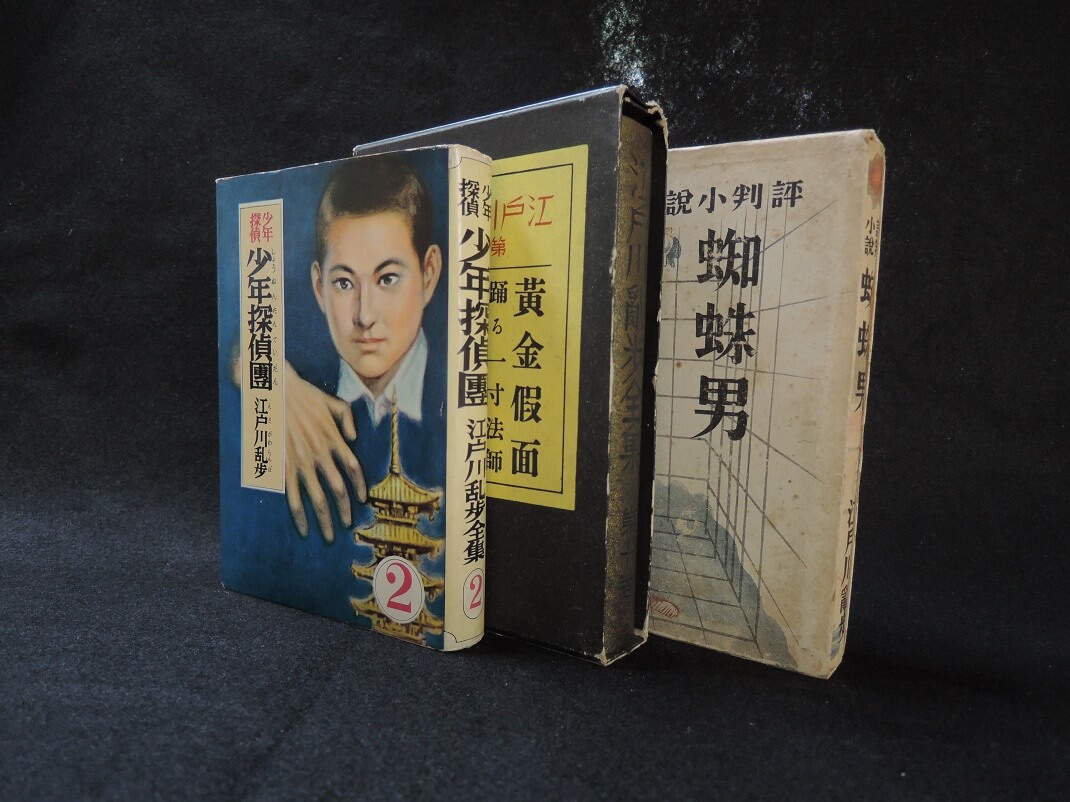
Rampo’s mystery novels are usually focused on early authentic mystery stories, such as 『D坂の殺人事件』 and, in his later years, 『少年探偵団』series, but from the point of view of Popular Culture Studies, popular long novels (e.g. 『蜘蛛男』『吸血鬼』), which have not been focused on, are more worthy of note than detective stories. These novels were supported overwhelmingly by the public in Showa modern era, and utilized accumulated findings and know-how. Besides, it is possible to consider that 『少年探偵団』series were released through these novels, so popular long novels can be evaluated as a center of Rampo’s mystery novels.
After the Great Kanto earthquake, Tokyo changed significantly. Roads were improved radically and the number of one-yen taxis (円タク) increased rapidly. Residential areas expanded into suburban, rakish and new residential areas were developed along private railways. Finally, semi-European-style houses with white wall and red roof were admired among people. The notion of rich people’s life was changed into a Western-style one: a modern drawing room equipped with a sofa, steam heating, a desk, and a desk phone were highlight features. People in western clothing, called “modern boy and modern girl”, appeared in public, pants with wide hems and long skirts were in fashion. At that time, Mr. Akechi, dressed with modern clothing, took up his place in a modernized office and was involved in a car chase with villains for the first time in Tokyo. These were notably popular long novels in this period. At the same time, not only cars and telephones, but also airships, balloons, elevators, airplanes, motorboats appeared as 20th century scientific civilization, which was admired among public readers.
Whereas Rampo’s previous works were for authorities’, in other words “closed”, popular long novels which reflect audience’s interest and society maximized the possibility of Rampo’s mysteries. It also led to novel woks for boys. These novels became popular precisely because they combined mystery and common experiences.
After the Great Kanto earthquake, Tokyo changed significantly. Roads were improved radically and the number of one-yen taxis (円タク) increased rapidly. Residential areas expanded into suburban, rakish and new residential areas were developed along private railways. Finally, semi-European-style houses with white wall and red roof were admired among people. The notion of rich people’s life was changed into a Western-style one: a modern drawing room equipped with a sofa, steam heating, a desk, and a desk phone were highlight features. People in western clothing, called “modern boy and modern girl”, appeared in public, pants with wide hems and long skirts were in fashion. At that time, Mr. Akechi, dressed with modern clothing, took up his place in a modernized office and was involved in a car chase with villains for the first time in Tokyo. These were notably popular long novels in this period. At the same time, not only cars and telephones, but also airships, balloons, elevators, airplanes, motorboats appeared as 20th century scientific civilization, which was admired among public readers.
Whereas Rampo’s previous works were for authorities’, in other words “closed”, popular long novels which reflect audience’s interest and society maximized the possibility of Rampo’s mysteries. It also led to novel woks for boys. These novels became popular precisely because they combined mystery and common experiences.
Book Storehouse and Collections
The storehouse was designated a cultural asset of Toshima-ku in March 2003. At first, the Edogawa Rampo Residence was built as a second house of SAKA Sukeo in Higashi-ku, Osaka prefecture, and then, it became a rented house. After that, Rampo had started to live there since 1934, and had owned it since 1952. Finally, Rikkyo University have owned the property since March 2002. The University started reconstruction with the aid of Toshima-ku in 2003, and completed work in 2004. Since an exhibition “Edogawa Rampo in the 20th Century” on August 2004, the book storehouse has been open to the public. However, it is open only near the entrance in order to maintain its condition.
There are many examples of keeping a collection (for example “Soseki Bunko” at Tohoku University), but the Edogawa Rampo Residence is very rare in the sense that the book storehouse is also preserved. Furthermore, the book storehouse has a unique atmosphere, and its owner never threw materials away (on the other hand, Matsumoto Seicho did threw them away after writing), so Rampo’s collection is a very rare type. Although people might just call it a “collection” or “preserve collection”, its contents are infinite in variety.
The Rampo’s collection had originally been preserved in main 3 parts; ①the inside of the book storehouse, ②remodeling storehouse under the eaves, ③main buildings and a Western-style house, but now, this collection is preserved separately; the inside of the book storehouse, main buildings, and the Rikkyo University Library, because of reconstruction and removal the eaves. You can see this collection in the Rikkyo University Library online. The numbers are as follows: Japanese books (included translated versions) are about 13000, foreign books are about 2600, and magazines are about 5500. Although it is not for public, there are 950 items, and 3500 books here. To research an author’s collection, it is common to research about the trends of a collection or style of handwriting. However, because Rampo’s collection is preserved in different parts, more archeological or collection-dismantling studies will be necessary.
There are many examples of keeping a collection (for example “Soseki Bunko” at Tohoku University), but the Edogawa Rampo Residence is very rare in the sense that the book storehouse is also preserved. Furthermore, the book storehouse has a unique atmosphere, and its owner never threw materials away (on the other hand, Matsumoto Seicho did threw them away after writing), so Rampo’s collection is a very rare type. Although people might just call it a “collection” or “preserve collection”, its contents are infinite in variety.
The Rampo’s collection had originally been preserved in main 3 parts; ①the inside of the book storehouse, ②remodeling storehouse under the eaves, ③main buildings and a Western-style house, but now, this collection is preserved separately; the inside of the book storehouse, main buildings, and the Rikkyo University Library, because of reconstruction and removal the eaves. You can see this collection in the Rikkyo University Library online. The numbers are as follows: Japanese books (included translated versions) are about 13000, foreign books are about 2600, and magazines are about 5500. Although it is not for public, there are 950 items, and 3500 books here. To research an author’s collection, it is common to research about the trends of a collection or style of handwriting. However, because Rampo’s collection is preserved in different parts, more archeological or collection-dismantling studies will be necessary.
Animation about the Edogawa Rampo Residence (about 10 minutes)
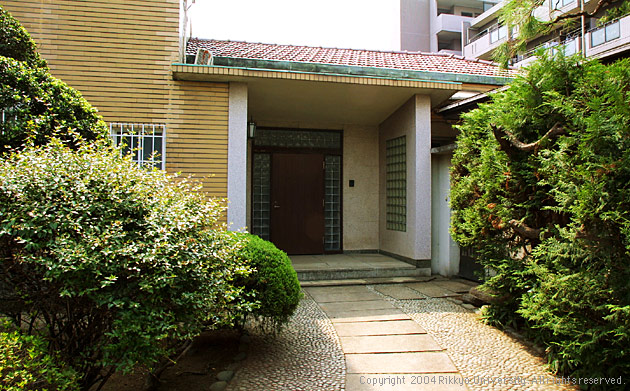
Entrance

Look out into the yard from entrance

A corridor
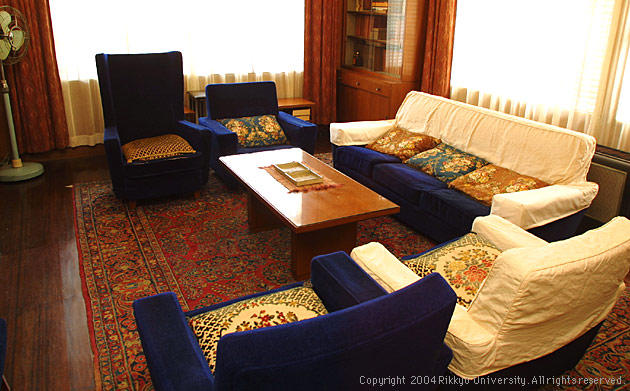
A drawing room with high-ceiling and warm sunshine
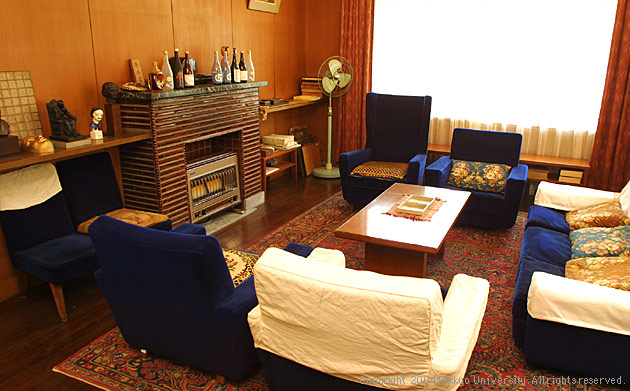
The inside of a drawing room
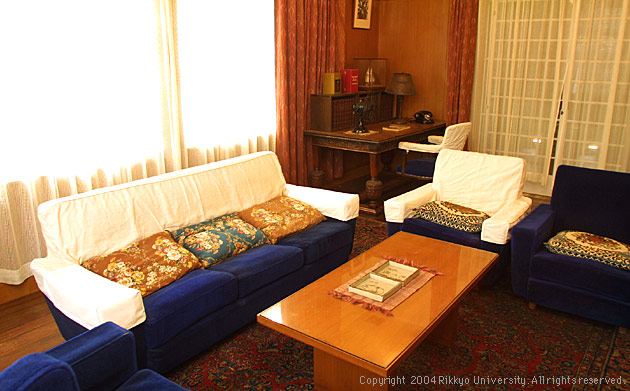
The inside of a drawing room
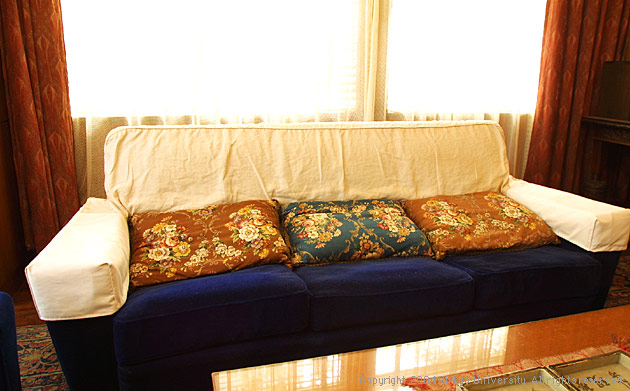
A rich sofa

A desk that Rampo used
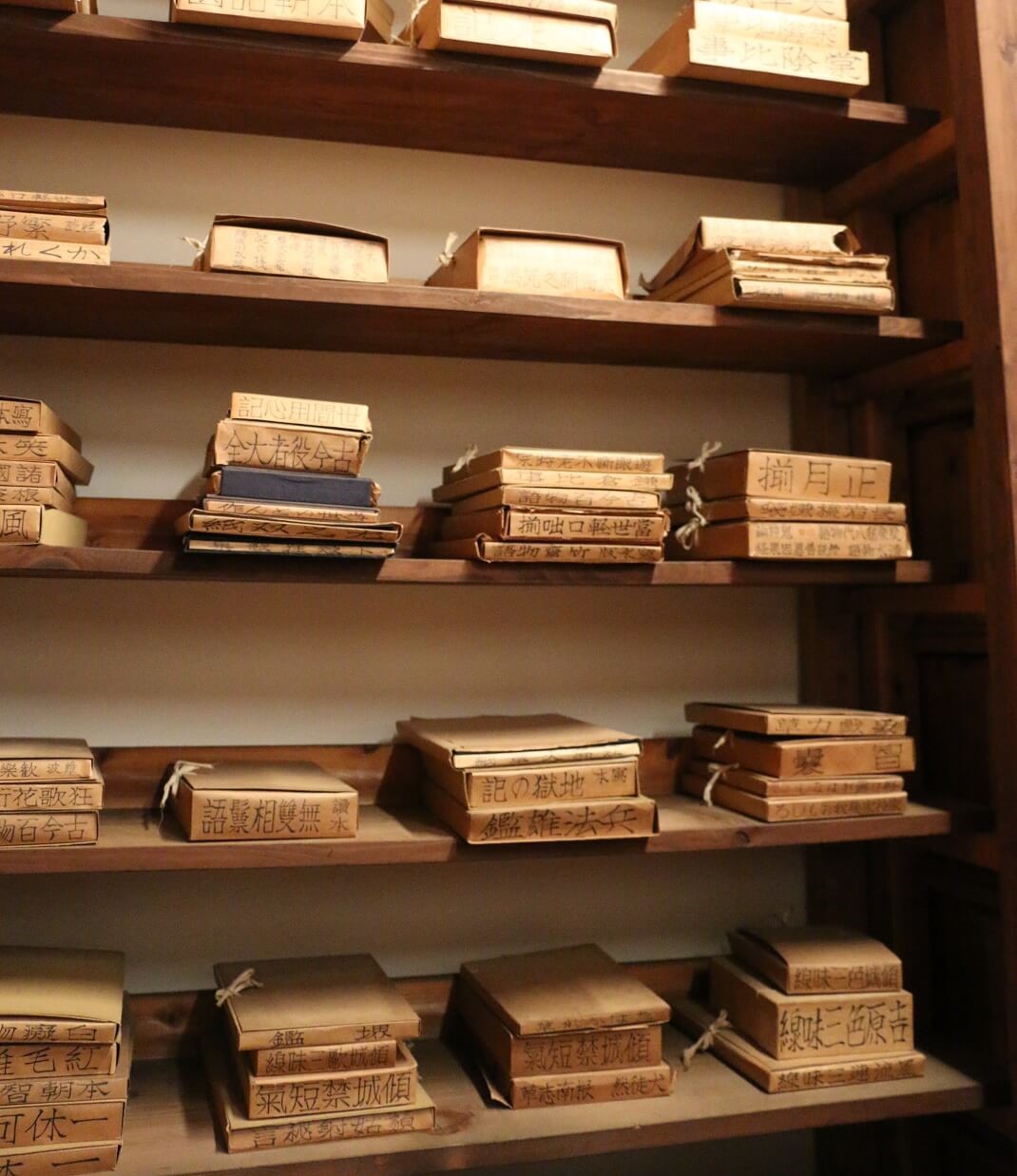
Edogawa Rampo is very famous as a mystery writer and also a collector of modern time’s materials. The following are some of them. You can search in more detail in OPAC of the Rikkyo University Library.
- 好色一代男/Koshokuichidaiotoko
- 好色五人女/Koshokugoninona
- 男色大鑑/Nanshokuookagami
- 西鶴諸国はなし/Saikaksyokokuhanashi
- 西鶴置土産/Saikakuokimiyage
- 若衆物語/Wakasyumonogatari
- 衆道物語/Shudomonogatari
- 犬つれづれ/Inutsurezure
- 傾城手管三味線/Keisheitekudazyamisen
- 出来斎京土産/Dekisaikyomiyage
- 手妻はや合点(ほか)/Tedumahayagaten
- 安政雑志/Ansheizasshi
- 地球全図/Chikyuzenzu
- 古今和歌集/Kokinwakasyu
130th anniversary of the birth of Edogawa Rampo
The year 2024 marks the 130th anniversary of the birth of Edogawa Rampo. Rikkyo Gakuin will also be celebrating its 150th anniversary. In preparation for this upcoming memorial year, we will be presenting a variety of contents with guests who have a connection to Rampo and who love Rampo and his works.
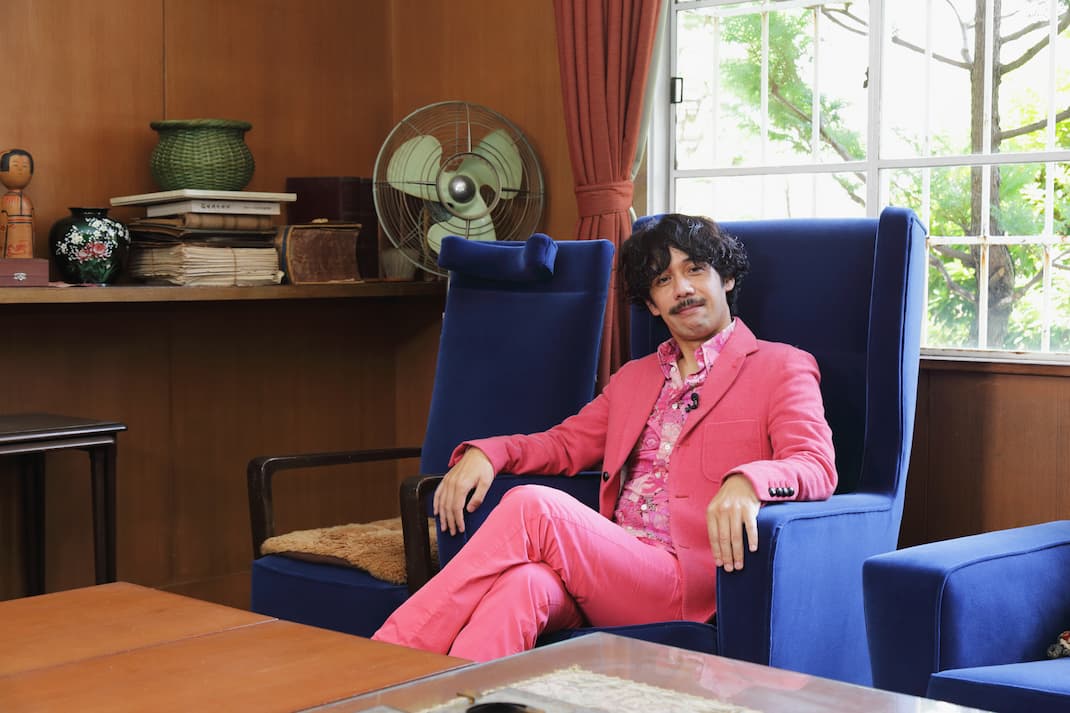
Formed in Paris in 2000, Les Romanesques performed live at the Paris Collection, served as ambassadors with Jane Fonda and the mayor of Paris at the 8th Paris International Film Festival, and took the world by storm as “the most famous Japanese in France”. After returning to Japan in 2011 to perform at Fuji Rock Festival, he was selected to be a main cast member of NHK Educational TV (ETV)'s Otsuta-to-Denjiro and has since been involved in a wide variety of other activities. A big fan of author Edogawa Rampo, TOBI gives his thoughts on Rampo's appeal.

Named after an Edogawa Rampo novel, the hard rock band NINGEN ISU (which translates to “The Human Chair”) was formed by members who love Rampo. The band has released numerous songs based on Rampo’s and others’ literary works. It is popular both at home and abroad as one of Japan’s leading hard rock bands. This time, we invited Shinji Wajima, guitarist and vocalist of the band, to the Edogawa Rampo Residence to share his unique view of Rampo and how he fuses Rampo’s works with rock music.
Browsing materials
- Collections are all closed stack system.
- In principle, users cannot borrow materials.
- For the reason of preserving materials, users cannot use pens, included ballpoint pens, and ink pens, but can use pencils.
- Depending on materials, users must wear gloves. We can lend them.
- In case that materials degenerate or are damaged, users cannot browse them.
- For other of Rampo’s old modern materials, please contact the Rikkyo University Library.
- Pre-application is required to browse and use materials.
- Users can browse materials which are located at “The Edogawa Rampo Residence” in the Rikkyo University Library OPAC (Online Public Access Catalog).
- Please make sure that you send us a given-application-form (title of materials, location, call number, preferred date, and purpose) by e-mail or post no later than 1 week before you visit our center.
For an application:
rampo@rikkyo.ac.jp
The Edogawa Rampo Memorial Center for Popular Culture Studies, Rikkyo University3-34-1
Nishi-Ikebukuro, Toshima-ku, 171-8501, Tokyo, Japan
- ※ Maximum 10 items per 1 application
- ※ Users can browse materials during our opening hours (every Monday, Wednesday, and Friday. 10:30 am-4:00 pm.) You must return materials between 12:00-13:00 because of break time.
- Materials are photocopied by our staff member (on-campus:10yen; off-campus: 50yen black & white only).
- Pages included something writing are not allowed to be copied (Another application form is needed).
- Users cannot photocopy material in the case of bad condition, or a large number of pages. (The magazine “Shin seinen (新青年)” is prohibited from photocopying because of degeneration. You can browse the reprinted edition in library.)
- The photocopied materials must be for individual study or research.
- In the case of photocopied materials for a profit, users must apply in advance. Please submit a voluntary proposal document. You must pay royalties based on the Rikkyo University Library guidelines.
Photocopying application form (PDF) *Japanese version only
Photocopying application form (Excel) *Japanese version only
Supports and Donations
We are collecting donations for Rikkyo. Users can assign the use of The Rampo Residence’s activities.
Donations will be used for maintenance and management of The Edogawa Rampo Residence.
Donations will be used for maintenance and management of The Edogawa Rampo Residence.
Contact Us
The Edogawa Rampo Memorial Center for Popular Culture Studies (The Edogawa Rampo Residence)
Mailing Address: 3-34-1 Nishi-Ikebukuro Toshima-Ku, Tokyo, 171-8501 JAPAN
E-mail:rampo@rikkyo.ac.jp
E-mail:rampo@rikkyo.ac.jp
Business Hours: From 10:30-16:00 on Every Wednesday and Friday (Except national/public holidays),and Special Exhibition Day
